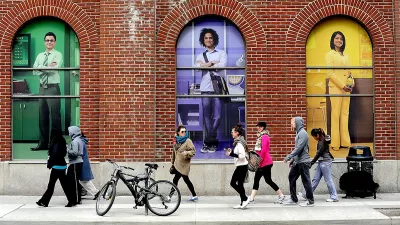United States
The State of Preservation Policy in L.A. County: Not Great (with Some Exceptions)
The Los Angeles Times reports on the Los Angeles Conservancy's 2014 Preservation Report Card, which "grades" each of L.A. County's local governments on their preservation programs (or lack thereof).
Mapping the Health of America’s Counties
The Robert Wood Johnson Foundation, in partnership with the University of Wisconsin Population Health Institute, this week released the annual County Health Rankings. The rankings aim to inspire healthy community action.
Is this Closure? Bank of America Settles with FHFA for $9.3 Billion
The Federal Housing Finance Agency (FHFA) announced a $9.3 billion settlement with Bank of America following a 2011 suit tied to the bank’s role in selling faulty mortgage-backed securities to Fannie Mae and Freddie Mac.
Energy Economics: Europe Pays Steap Price For Opposing Fracking
When it comes to fracking, much dialog is about energy vs. environment. Not this one. NPR reports on the economic consequences of Europe's rejection of fracking. Many European companies are setting up shop in the U.S. where energy may cost 75% less.

The Most Dangerous Small Towns in America
Where are the most dangerous—and least populated—places to live in America? Surprisingly, none are on the west coast.
Graphic Reveals Cardinal Orientation of Street Grids
Seth Kadish says he was born with an innate sense of direction. As such, he appreciates street grids oriented to cardinal directions. The phenomena interested him enough to create a graphic that visualizes the orientation of 12 urban areas.
Commuter Taxes: An Untapped Revenue Source?
For all those cities that double population during the work day, here's a revenue thought to consider. But why restrict it to in-bound commuters? What about residents who commute-out of the city? Is the commuter tax a legitimate revenue source?
What Do Urban Trends Mean for Banks?
A recent article describes the context of urbanization around the country before examining the implications of the trend for the decisions made by bankers—i.e., where and how to invest—especially given the realities of the post-recession economy.

The Technology of Walkability
A recent article explores the promise—and potential pitfalls—of new technology to support the growing popularity of urban pedestrianism.
The Mercados Project: Lessons for the Revival of Markets
Historically, central markets served as grand social and commercial hubs for U.S. cities. A period of 20th century decline interrupted the evolution of markets, but creative and diverse examples have precipitated a recovery around the country.
How Utilities Fail to Predict the Economic Effects of Environmental Regulation
A familiar refrain: the EPA proposes new regulation of energy production, and the utility industry responds that new requirements will increase costs. The Center for American Progress recently looked back at how clairvoyant those claims proved to be.
Report: New Techniques and Technology for Monitoring Active Transportation
The growing popularity of active transportation requires planners and advocates to better survey how, where, and when people are biking and walking. A new study by the Transportation Research Board shares the cutting edge of survey techniques.
More Criticism of Transit Record Claims
A pair of articles pushes back on a recent study that claims public transit use in the United States is reaching record levels.
Are Environmentalists Digging Their Own Fracking Hole in Opposing Natural Gas Exports?
In a pair of articles, The Hill's energy and environment blogger Timothy Cara looks at political efforts to increase natural gas exports to Europe on account of Russia's annexation of Crimea, part of Ukraine, and environmental groups opposed to it.
Regulation Success Story: Diesel Emissions Greatly Reduced
Thanks to the 2010 federal requirement of ultra-low sulfur diesel fuel and new Tier 4 emissions standards by the EPA, particulate emissions from non-road diesel engines, including agricultural and construction equipment, have been reduced by 99%.
Social Justice Through Tiny House Communities
Tiny houses aren’t just for eco-warriors. They can also be a means for homeless and mentally ill individuals to reenter mainstream society.
N.C. Coal Ash Spill Sheds Light On Role Played by EPA
The federal investigation of Duke Energy's Feb. 2 coal ash spill sheds light not only on the company and its state regulator, but also on that of the Environmental Protection Agency and holds wider implications for the coal industry as a whole.
Rejecting the Popular Transit Ridership Narrative
A recent study claimed that transit ridership had reached the highest levels seen in 57 years. Wendell Cox, however, argues that the narrative about a “fundamental shift” in the transportation paradigm is a misrepresentation of the truth.
Is Providence, RI the Most Exciting Mid-Size City in America?
You’re totally forgiven for snickering; most people wouldn’t have guessed that a city in Rhode Island would have made it anywhere near the top of a list of exciting cities.

The Underlying Patterns of Urban Street Design
Based on empirical study, J. Alexander Maxwell and fellow University of Strathclyde researchers, in collaboration with Chuck Wolfe, argue for recalling historic patterns of pedestrian city settings in contemporary urban design and policies.
Pagination
Urban Design for Planners 1: Software Tools
This six-course series explores essential urban design concepts using open source software and equips planners with the tools they need to participate fully in the urban design process.
Planning for Universal Design
Learn the tools for implementing Universal Design in planning regulations.
planning NEXT
Appalachian Highlands Housing Partners
Mpact (founded as Rail~Volution)
City of Camden Redevelopment Agency
City of Astoria
City of Portland
City of Laramie


































